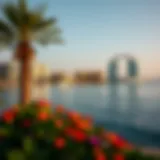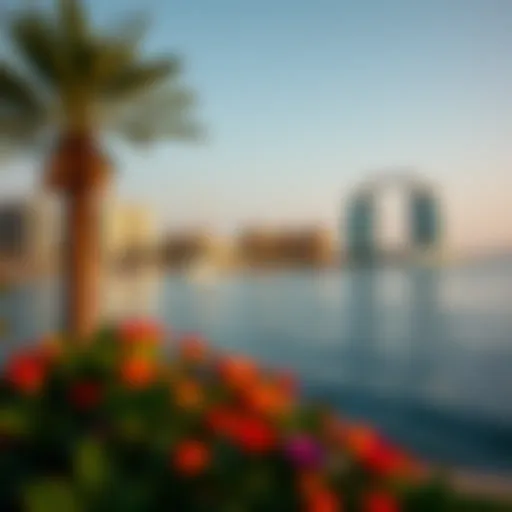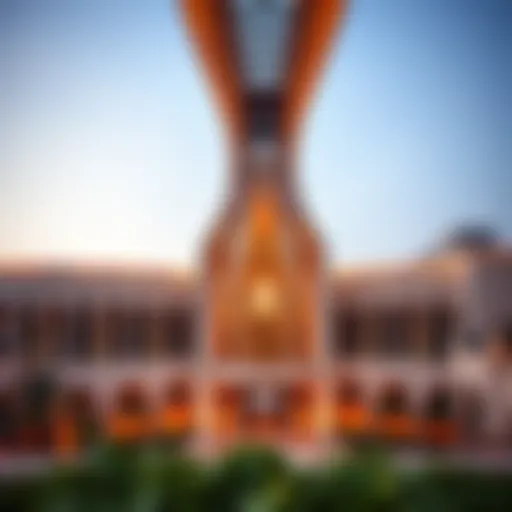Footprint Real Estate in Dubai: Market Insights


Intro
Understanding the footprint real estate market in Dubai is more than just skimming the surface; it's like peeling an onion—layer upon layer of complexity that reveals both opportunities and challenges. With the Emirate's glittering skyline and captivating desert backdrop, perhaps no other city in the world has crafted a property narrative as engaging and vibrant as Dubai. Investors, whether local or international, are drawn to its pulse, eager to benefit from a market known for its unique dynamics and potential for high returns.
In this article, we aim to dissect the intricacies of the Dubai real estate scene. We’ll explore various factors that influence buying decisions, shifts in customer tastes, the evolving regulatory landscape, and emerging trends that may shape the future of real estate in this bustling city. This comprehensive guide will not only help potential buyers and property managers make informed choices but will also serve as a strategic roadmap for navigating this sometimes daunting sector.
Market Trends
Current Real Estate Market Conditions
The Dubai real estate market has seen fluctuations reminiscent of the shifting sands of the desert. As of late 2023, it’s in a recovery phase, showing an upswing in various segments after knee-jerk declines. Property prices are stabilizing, with demand reaching new heights, particularly in premium locales like Downtown Dubai and Dubai Marina. Foreign investment has been a significant driver, bolstered by the city's favorable policies towards expatriates.
Key indicators of current market conditions include:
- Increase in property transactions: A notable surge in sales, particularly of luxury apartments and villas.
- Demand for off-plan properties: More buyers are looking to invest in properties that aren't yet developed but promise significant returns.
- Strong rental yields: Investing in rental properties continues to be attractive, yielding as much as 7% to 10% in various neighborhoods.
Despite these positive signals, challenges remain. Factors such as regulatory changes, economic shifts, and the global market's unpredictability can alter the landscape abruptly.
Future Projections and Growth Areas
Looking ahead, the Dubai real estate market is poised for growth. Some areas are particularly ripe for investment:
- Dubai Creek Harbour: A place where nature and modern architecture coexist, this area promises innovative projects that attract attention.
- Dubai South: Positioned strategically near the Expo 2020 site, this area is expected to grow as it houses logistics hubs and future residential projects.
- Jumeirah Village Circle (JVC): Known for its affordable living options, JVC has become a hotspot for young professionals.
"The future of Dubai real estate hinges on adaptability and sustainability, with a focus on developing green spaces and affordable housing."
With the introduction of new policies aimed at fostering sustainability and smart city initiatives, the outlook remains bright for those willing to embrace the changing landscape. Investors should keep their eyes peeled for opportunities springing up in areas that align with these long-term goals.
Investment Insights
Best Areas for Real Estate Investment
Certain neighborhoods stand out as havens for savvy investors. Here are several areas worth considering for solid investments:
- Downtown Dubai: Bustling with life and iconic landmarks, it remains at the forefront of luxury living.
- Palm Jumeirah: Known worldwide for its unique palm-tree shape and high-end villas, this area offers a prestigious address.
- Business Bay: A hub for commercial activity, it attracts both business and residential tenants, ensuring a steady stream of rental income.
Tips for First-Time Investors
Entering the Dubai real estate scene can be daunting for novices. Here are a few tips to ease the transition:
- Do your homework: Research extensively about neighborhoods, market trends, and potential returns.
- Consider legalities: Familiarize yourself with property laws, especially if you're a foreign investor.
- Engage a local expert: A reliable real estate agent can provide invaluable insights and help steer clear of potential pitfalls.
By equipping oneself with the right knowledge and tools, potential investors can find their footing in this exciting yet complex arena while maximizing their investment potential.
Prologue to Footprint Real Estate
Understanding footprint real estate in Dubai is akin to grasping the very essence of the city’s rapid urban transformation. As one of the world's most dynamic real estate markets, Dubai offers a wealth of opportunity, where property investments can yield significant returns. But why is it pertinent to discuss footprint real estate specifically?
Footprint real estate encompasses not just the physical structures but also the overall space they occupy, including how these spaces integrate with their surroundings. This perspective is crucial for investors and property managers alike, as it affects property value, accessibility, and overall return on investment.
In essence, delving into footprint real estate aids potential buyers in realizing the interplay between their investments and the larger urban ecosystem. It equips investors with knowledge about how developments in infrastructure, zoning, and local culture influence real estate dynamics.
Definition and Importance
To put it simply, footprint real estate refers to the total area of land that buildings occupy and how that land is optimally used. The significance of this concept in Dubai is multifaceted:
- Urban Density: As Dubai continues to expand, understanding the distribution of density becomes critical. An optimized footprint means more efficient land use, which can lead to increased property value.
- Sustainability: The footprint concept also encourages sustainability. Developers are increasingly focused on lower environmental impact and energy-efficient designs, which can set properties apart in a competitive market.
- Investment Viability: For investors, analyzing footprint provides insights into potential growth areas. A property with a strategic footprint may offer better adaptability for future developments, enhancing long-term value.
Recognizing these aspects underscores why footprint real estate should be a priority for interested parties navigating Dubai's vibrant property market.
Historical Context in Dubai
Dubai's real estate narrative cannot be separated from its ambitious vision to become a global hub. The historical backdrop is rich and informative:
- Early Developments: The real estate journey began with basic construction projects in the 1940s focused on residential needs. As oil was discovered, the tide shifted, and the landscape began to transform dramatically.
- Economic Transitions: By the late 20th century, Dubai embarked on diversifying its economy, investing heavily in tourism and retail, which in turn spurred on a real estate boom. The introduction of freehold ownership in 2002 allowed foreign investors into the market, significantly altering its landscape.
- Urban Planning Reforms: With the increase in high-rise developments and master-planned communities, understanding footprint became essential for urban planners and investors alike. Developments like Burj Khalifa and Palm Jumeirah encapsulate the aspirations of the city while emphasizing innovative land use.
This context is indispensable for understanding current trends and potential future directions in Dubai's footprint real estate market.
In short, recognizing how past trends inform the present is crucial for anyone looking to invest in Dubai's ever-evolving landscape.
Current Market Landscape
The current market landscape of footprint real estate in Dubai is incredibly dynamic and multifaceted, serving as a compass for potential investors, home buyers, and property managers. As one of the most vibrant and rapidly growing property markets globally, Dubai attracts a diverse array of stakeholders who seek both luxury and functional real estate solutions. In this section, we will break down key trends, market segments, and geographic factors that influence the pulse of this bustling market.
Key Trends
In recent years, several trends have emerged that shape Dubai's footprint real estate. These include:
- Growing Demand for Sustainable Developments: There is a noticeable shift towards eco-friendliness in both commercial and residential properties. Developers are increasingly focusing on green building technologies.
- Rise of Remote Work Influence: The pandemic shifted lifestyle preferences, leading many individuals to seek more spacious and comfortable living arrangements, which in turn affects property demand.
- Technological Integration: Smart home technologies and digital platforms are making their mark. Investors are becoming more inclined toward properties that incorporate advanced tech solutions for security and energy efficiency.
- Demand for Mixed-Use Developments: The lines are blurring between residential, commercial, and recreational spaces. People favor living in areas where they have everything at their fingertips — shopping, parks, cafes — all within reach.
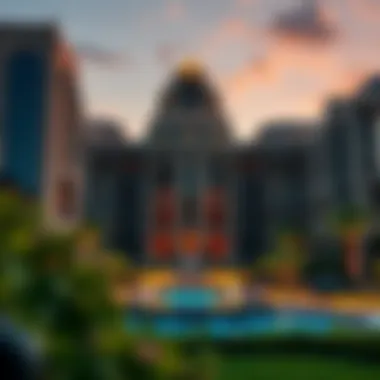

"The future of living in Dubai is not just about luxury but about convenience and sustainability. Investors have to adapt to these patterns to stay relevant."
Market Segments
When dissecting the footprint real estate market, it’s crucial to identify the various segments:
- Luxury Real Estate: High-end properties continue to flourish, particularly in sought-after neighborhoods such as Downtown Dubai and Palm Jumeirah. Investors often see these high-value assets as reliable stores of wealth, especially in a market characterized by volatility.
- Affordable Housing: A growing population means that there is also rising demand for affordable housing. Projects offering competitive pricing with quality amenities cater to a broader range of buyers.
- Commercial Real Estate: For organizations and entrepreneurs eyeing Dubai for business opportunities, commercial spaces in key locations provide an avenue for growth. Office spaces, retail properties, and mixed-use developments remain highly sought after.
- Industrial Real Estate: With Dubai’s strategic position as a logistics hub, industrial real estate is gaining traction. Warehouses and distribution centers are springing up, spurred by e-commerce growth.
Geographic Exploration
Dubai consists of various districts, each with its own character and offerings. Understanding these geographic nuances is essential for making informed decisions:
- Dubai Marina: Known for its waterfront views and luxury condos, this area attracts a younger demographic and expatriates seeking a vibrant lifestyle.
- Jumeirah Lake Towers (JLT): This locality offers a mix of residential and commercial properties, appealing to professionals who prioritize accessibility and amenities.
- Business Bay: Situated near Downtown, this area is bustling with corporate offices. Investors are keen on the potential of both residential and office spaces here.
- Dubai Silicon Oasis: This tech-focused community combines residential, educational, and industrial spaces, showcasing the importance of innovation in property development.
In sum, the current market landscape encapsulates a rich tapestry of trends, segments, and geographic insights that define Dubai's footprint real estate. For investors and buyers aiming to navigate this ever-evolving market, a profound understanding of these elements is vital to seize opportunities and make informed decisions.
Investment Considerations
When diving into the world of Dubai's footprint real estate, the importance of investment considerations cannot be overstated. This is where opportunities can spring forth, but with those come certain pitfalls. Understanding the nuances of finance, risk, and investment timelines is crucial for both seasoned investors and newcomers alike. Grasping this section will not only give clarity but also empower investors to make informed decisions that could yield significant returns.
Financial Opportunities
The financial landscape in Dubai offers a plethora of opportunities for investors looking to tap into the real estate market. With the city's rapid development, the returns on investment can be quite impressive. Rental yields are notably high compared to other global cities. For instance, properties in areas like Dubai Marina and Downtown Dubai can fetch rental yields of around 7% to 8%, making them attractive destinations for passive income.
Moreover, Dubai's favorable tax environment plays a significant role. There are no property taxes to contend with, which makes the net income for investors more appealing. In addition, the government's push for long-term residency visas for property investors can further incentivize investments, allowing for stability and peace of mind.
"Investors in Dubai's real estate sector often find themselves in a no-tax zone, which enhances their financial gains significantly."
However, awareness is key. Market adaptability is essential as economic conditions can shift unexpectedly, urging investors to keep their ear to the ground. Having an updated understanding of market trends and conducting thorough property evaluations can unveil lucrative opportunities.
Risk Factors
Despite the golden prospects, every rose has its thorns. The risks involved in investing in Dubai's real estate must be fully recognized. Market volatility is a significant concern, especially in times of economic downturns or global crises. Property values can fluctuate drastically, leading to potential losses. For example, the global financial crisis of 2008 saw property prices in Dubai drop by nearly 50%, impacting many investors heavily.
Additionally, reliance on foreign investors can pose risks. Political or economic changes can have immediate effects on the market, so keeping informed about global happenings is advisable.
Furthermore, the regulatory landscape is also a potential minefield. Investors must arm themselves with knowledge of ownership regulations, as certain areas may have restrictions. Failing to adhere to these regulations may result in losing investments and possibly facing legal actions.
Long-Term Vs Short-Term Investment
Finally, it’s vital to evaluate the distinction between long-term and short-term investment approaches. Short-term investments might provide quicker returns, but they come with their own set of challenges. The property flipping trend, for instance, is popular but requires precise timing, thorough market knowledge, and often, considerable capital for renovations.
On the other hand, long-term investments offer stability and the potential for appreciation in value over time. Holding onto a property in a growing area like Dubai South can yield significant financial benefits. Properties bought years ago have appreciated substantially, demonstrating how patience rewards the investor in the long run.
In summary, investors must weigh their risk tolerance and financial goals carefully. A comprehensive understanding of financial opportunities, accruing risks, and the nuances of investment timelines can be the compass investors need in navigating the profitable yet intricate landscape of Dubai’s footprint real estate.
Regulatory Environment
Understanding the regulatory environment surrounding footprint real estate in Dubai is crucial for any investor or buyer. It's a framework that can either pave the way for success or, conversely, create significant barriers. The laws and regulations governing property ownership, zoning, and licensing play a pivotal role in shaping market dynamics and determining potential profitability.
Navigating these rules effectively can unlock numerous opportunities while protecting investments from unforeseen challenges. For instance, knowing the ins and outs of ownership laws can make a world of difference in securing a desirable property. Investors who are informed can avoid missteps that might lead to financial loss or legal complications.
Ownership Laws
In Dubai, ownership laws delineate who can buy property and under what conditions. It's essential for potential buyers to grasp the difference between freehold and leasehold properties.
- Freehold Properties: Allow full ownership of both the land and the building. Many foreigners can purchase freehold properties in designated areas, significantly appealing to international investors.
- Leasehold Properties: Here, ownership is limited to a specific period, often 99 years, after which the land reverts to the original owner. This type can pose risks if the property depreciates in value before the lease ends.
Issues around ownership extend beyond just the types of properties. The Dubai Land Department (DLD) oversees property registration. Ensuring that the property is registered legally is not just prudent; it is a requirement for smooth transactions and for retrieving any lost funds in the event of disputes.
Zoning Regulations
Zoning regulations dictate how land can be used within the emirate. In essence, these laws can impact everything from the type of property that can be built in a certain location to regulations regarding the property height, density, and purpose.
For developers and investors, understanding zoning is key to ensuring that their plans for a property align with local regulations. Common zoning types in Dubai include:
- Residential Zoning: Areas designated purely for housing, often accompanied by limits on building heights and types to maintain neighborhood aesthetics.
- Commercial Zoning: Areas where businesses can operate, usually with different stipulations regarding space and design to foster healthy commerce.
- Mixed-Use Zoning: This allows for both residential and commercial spaces, which can drive a vibrant local economy but also requires careful planning to ensure harmony between different needs.
Failing to comprehend zoning regulations can lead to costly litigation or the inability to proceed with planned developments. Thus, a careful review of zoning before investment is crucial.
Licensing Requirements
The licensing landscape can be complex for those looking to invest in or develop real estate in Dubai. Various licenses are required depending on the nature of the property transaction and the investor's goals. The major types include:
- Real Estate License: Essential for anyone looking to operate as a property owner or manager. Obtaining this requires a knowledge of local laws and adherence to regulations set out by the Dubai Economic Department.
- Building Permit: For those planning to develop or modify a structure, a building permit must be secured, ensuring compliance with building codes and safety regulations.
Gathering the necessary documents and meeting all requirements can be daunting but is vital for legal compliance. Failing to secure the right licenses can result in hefty fines or even project termination.
"Understanding the regulatory framework is not just a checkbox for investors; it’s a necessary foundation for building a viable real estate strategy in Dubai."
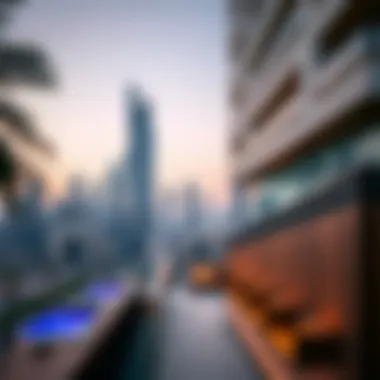

In summary, the regulatory environment encompassing ownership laws, zoning regulations, and licensing requirements creates a framework that demands thorough understanding. Proper navigation through this landscape positions the investor to maximize opportunities while minimizing risks associated with real estate in Dubai.
Sustainability Considerations
In the realm of real estate, sustainability has become more than a mere buzzword; it signifies a critical pivot towards a more responsible and conscious approach in property development. The footprint real estate sector in Dubai has begun to embrace sustainability not just for compliance but as a core principle that can drive long-term viability and prosperity. Addressing this topic is essential for investors and developers alike, as the implications of eco-friendly practices resonate far beyond environmental concerns—they impact economic growth, social equity, and overall quality of life.
Eco-Friendly Developments
The rise in eco-friendly developments represents a paradigm shift in how properties are designed, constructed, and operated. No longer are developers simply focused on constructing buildingss that serve a functional purpose. Instead, there is a concerted effort to integrate sustainable materials and energy-efficient technologies. Here are several examples of eco-friendly initiatives that are gaining traction:
- Use of Green Materials: Developers are increasingly sourcing sustainable materials that minimize environmental impact. This includes repurposed materials, bamboo, and sustainably sourced timber.
- Energy Efficiency: Building models now frequently incorporate energy-efficient appliances, smart home technologies, and solar panels, which significantly reduce energy consumption and costs over time.
- Water Conservation Systems: With Dubai’s arid climate, implementing water-saving fixtures and rainwater harvesting systems becomes vital in new developments.
These eco-conscious methods not only contribute to lower operating costs for homeowners but also enhance property values. The demand for sustainable living is rising, and properties with eco-friendly features are likely to see a greater appeal among environmentally aware buyers.
Impact on Urban Planning
Sustainability also interconnects deeply with urban planning in Dubai. It is essential to understand how these principles guide the growth and development of the city itself. Urban planners are increasingly adopting sustainable frameworks that prioritize green spaces, efficient public transport, and mixed-use developments. This approach serves multiple purposes:
- To Reduce Urban Sprawl: Compact, mixed-use developments can minimize commuting times and reduce reliance on cars, thereby lowering greenhouse gas emissions.
- Enhance Public Health: Incorporating parks and green spaces encourages physical activities and contributes to better air quality. Planners are emphasizing public health through access to clean environments and active lifestyles.
- Social Inclusion: Sustainable urban planning aims to create communities where diverse populations can live harmoniously. By integrating affordable housing within eco-friendly developments, planners support social equity.
In sum, sustainability considerations in Dubai's footprint real estate extend beyond mere compliance; they forge pathways to innovation, efficiency, and a brighter urban future. As investors increasingly recognize these factors, they are poised to become pivotal in shaping Dubai’s landscape.
"Sustainable development is about far more than simply protecting the environment; it is also about creating cohesive and resilient communities that support future generations."
In embracing these sustainability measures, Dubai positions itself not only as a leader in architectural innovation but also as a city that genuinely values its citizens and their environment.
Footprint in Urban Development
The footprint of real estate in Dubai can't be overstated; it plays a crucial role in the broader narrative of urban development. As one of the fastest-growing cities in the world, Dubai presents a fascinating case study of how real estate shapes, and is shaped by, urban dynamics. This section delves into the essential relationship between real estate and urban development, primarily focusing on how various elements interact to create a cohesive urban experience.
Integration with Infrastructure
Infrastructure serves as the backbone of any city's growth and development. In Dubai, the integration of real estate projects with existing infrastructure is paramount. Here, roads, public transport, and utilities must not only meet current demands but also anticipate future needs. For instance, consider the rapid expansion of the Dubai Metro, which significantly enhances accessibility to various residential and commercial areas.
A well-planned integration can result in several benefits:
- Increased Property Values: Properties situated close to efficient transport links tend to appreciate quickly. Potential buyers are willing to pay a premium for easy access to their places of work or leisure.
- Enhanced Quality of Life: Residents benefit from reduced travel times, enabling more leisure and family time. This convenience translates into higher satisfaction rates within communities.
- Sustainability Considerations: Integrating mixed-use developments with green public transport can reduce the carbon footprint, promoting environmentally conscious living. The city has seen innovative designs, like Dubai Creek Harbor, which incorporate sustainable transport solutions right from the blueprint stage.
It's evident that without robust infrastructure integration, urban development risks stagnation. Thus, close cooperation between city planners, developers, and investors is essential for crafting a harmonious urban landscape.
Public Spaces and Amenities
When discussing the footprint of real estate in urban planning, public spaces often get overlooked, yet they are crucial for fostering community connections. An effective urban design incorporates public spaces that encourage interaction, recreation, and cultural activities. In Dubai, strides have been made in creating public amenities that enhance the quality of life for its residents.
- Parks and Recreation Areas: Parks like Al Barsha Pond Park and Safa Park offer much-needed green spaces amid the bustling city atmosphere. They’re places where families gather, and communities mingle, serving as tranquil havens from urban chaos.
- Cultural Amenities: The development of areas such as Al Seef along Dubai Creek illustrates how public spaces can complement the historical essence of the city while promoting modern developments. Spaces for exhibitions, art installations, and cultural festivals abound here, enriching the urban fabric.
- Accessibility of Services: Real estate that includes essential services like grocery stores, healthcare, and educational institutions within walking distance fosters a sense of community. The UAE's laws increasingly support mixed-use developments to encourage such arrangements.
Investment in public spaces is an investment in the community itself. As the real estate market continues to evolve in Dubai, maintaining a balance between development and the creation of inviting public spaces should always be a primary consideration. The benefits of a well-planned urban environment cannot be denied: happier residents, a vibrant culture, and robust property values all stem from thoughtful urban development.
Ultimately, it is this footprint of real estate that will define Dubai's urban landscape in the years to come.
Lifestyle Implications
The footprint real estate market in Dubai does more than just shape skyscrapers and apartment complexes. It deeply influences the lifestyle of its residents, impacting how communities and individuals interact with their environment. When considering a property investment, it is crucial to understand the lifestyle implications of footprint real estate, as these factors can dictate the living experience, community cohesion, and even influence property values over time.
One of the prime elements worth considering is community living. A well-planned real estate footprint encourages communal spaces, fostering connections among residents. Here, neighborhoods can flourish and bloom into vibrant hubs where social interactions thrive. Rather than merely being a collection of living spaces, these developments embrace the concept of shared experiences. For instance, places like Dubai Marina, famous for its waterfront views, are specifically designed to create avenues for socializing, complete with parks, cafés, and recreational facilities that beckon residents outdoors.
Community Living Considerations
In Dubai, community living is often characterized by a blend of cosmopolitan vibrancy and traditional Arabian charm. The layout of residential developments plays a pivotal role in encouraging interactions among residents. For example, in JUMEIRAH VILLAGE CIRCLE, community spaces such as parks and sports facilities are integrated into neighborhoods, making it more than a place to reside. These designs aim to instill a sense of belonging among the residents.
Moreover, considerations such as security, accessibility, and even noise levels can greatly influence community living experiences. Well-equipped residential properties prioritizing these aspects can elevate the quality of life for inhabitants. A friendly environment propelled by community events and gatherings can also motivate residents to participate, enhancing overall neighborhood connectivity.
While some might argue that lifestyle choices often take precedence over community interactions, studies show that people value environments that promote social cohesion. This trend echoes through expat markets where residents from various backgrounds come together, creating a rich tapestry of cultures within the community.
Influence on Local Culture
The cultural canvas of Dubai is constantly being shaped by its real estate developments. Footprint real estate doesn’t just offer physical structures but contributes to the cultural milieu of the city. The integration of different architectural styles and amenities responding to local taste speaks volumes. For instance, properties that include art galleries or cultural centers not only raise the aesthetic of the community but also serve as a testament to Dubai’s commitment to preserving its heritage.
Furthermore, such developments attract diverse populations, creating multicultural hotspots where traditions meld seamlessly with modernity. The impact is twofold: it allows locals to showcase their heritage while providing newcomers a taste of the authentic Dubai lifestyle.
As the city continues to grow, it remains essential for developers and investors alike to consider how their projects influence cultural perceptions and community identity. Promoting sustainable and culturally sensitive living environments can not only elevate lifestyle standards but also preserve the intrinsic values that make Dubai a unique metropolis.
A well-planned community in Dubai can transform a neighborhood into a vibrant social landscape, bridging gaps between cultures and traditions.
Challenges in the Footprint Market
The footprint real estate market in Dubai faces a medley of challenges that investors and stakeholders must deftly navigate. Understanding these challenges is vital not just for seasoned purchasers but for those new to the market as well. In a landscape where economic shifts can alter the playing field almost overnight, being aware of potential pitfalls empowers investors to make informed decisions.
Market Volatility
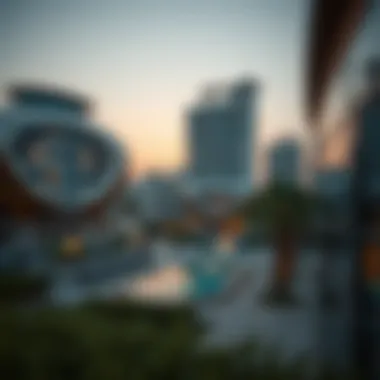

Market volatility in Dubai’s footprint real estate can be likened to a roller coaster ride; it has its ups and downs, and sometimes the drop can be steep. Fluctuations in property values can arise from various factors including changes in the economy, regulatory shifts, or even global events. For example, during economic downturns, demand for property can plummet, leading to price reductions that may seem alarming to new investors.
- Economic Trends: The real estate sector’s performance often mimics the broader economic conditions. For instance, when global oil prices drop, it might impact foreign investment in Dubai, thus resulting in a slower market.
- Investment Sentiment: Investor confidence plays a crucial role. When market sentiment is weary, it could halt new projects, resulting in a stagnation that directly affects existing property values.
- Supply and Demand Dynamics: Rapid construction sometimes leads to oversupply, causing properties to linger on the market longer than expected—all while prices may dip due to this saturation.
In navigating such volatility, strategic acumen is essential. It's not just a matter of spotting trends; one must also cultivate the patience to withstand short-term fluctuations for long-term gains.
Foreign Investment Barriers
Foreign investors often face a series of barriers when attempting to break into the Dubai real estate market. These hurdles can be a real buzzkill, deterring even the savviest of investors from making their move.
- Regulatory Hurdles: Foreign ownership regulations can be complex. While Dubai offers attractive incentives, investors still need to navigate ownership laws that sometimes restrict foreign holdings in certain areas. This adds a layer of complication that can be off-putting for newcomers.
- Cultural Differences: Understanding the social and cultural norms of Dubai can pose a challenge for foreign investors. Having local insights can make or break an investment.
- Funding and Financing Issues: Access to financing options can also be tricky for foreign entities compared to their local counterparts. International banks may not provide the same terms or flexibility, making the financing process a painstaking task.
"In any investment arena, understanding the hurdles is the first step towards overcoming them."
For more detailed regulations, resources like the Dubai Land Department can provide insights into ownership laws and procedures.
Future Projections
Understanding future projections in Dubai's footprint real estate market is paramount. This aspect not only shapes current trends but also illuminates potential pathways for investments and developments. As a rapidly evolving landscape, Dubai's property sector demands a keen eye for shifts in consumer preferences, regulatory changes, and macroeconomic factors.
Several elements intermingle to influence these future projections:
- Technological Integration: The influence of technology in real estate cannot be understated. From virtual reality tours to smart home features, technology is setting new standards for what properties offer.
- Sustainability Orientation: More than ever, both local and international buyers are leaning toward eco-friendly properties. This shift towards sustainability not only impacts design and construction but also enhances property values over time.
- Evolving Demographics: The influx of expatriates and shifts in local demographics drive demand for varied property types, ranging from luxury apartments to affordable homes for younger families.
These factors converge to paint a dynamic picture of future investments. For instance, as more people look for energy-efficient homes, properties that prioritize green technologies may see an increase in demand, leading to potentially higher profits for investors. Moreover, aligning developments with the UAE's vision for a more sustainable future could benefit investors who adapt early to these trends.
Emerging Trends
In the quest for clarity in future projections, we must examine current emerging trends shaping the landscape of footprint real estate in Dubai. These trends reveal not only investor sentiment but also how the market is likely to morph in the coming years.
Rise of Mixed-Use Developments
Mixed-use developments combine residential, commercial, and recreational spaces into cohesive units, catering to the lifestyle needs of urban dwellers. This format reflects a significant change in how developers approach property projects. Areas like Downtown Dubai and Dubai Creek Harbour are setting the tone for future developments, fostering vibrant communities.
Digital and Remote Selling
The paradigm shift towards digital platforms has revolutionized how transactions occur. With tools like virtual reality walkthroughs and online negotiation options gaining traction, buyers are now, quite literally, a click away from their dream properties. This digital transformation can significantly expedite transactions, appealing to an increasingly tech-savvy demographic.
Focus on Affordable Housing
Affordable housing is on the rise in Dubai, a response to a growing need among younger generations and expatriates. Developers are seeking out cost-effective ways to create livable spaces without sacrificing quality, which could soon become a focal point in real estate strategies.
Short-Term Rentals and Hospitality Integration
Short-term rentals are expanding as a viable alternative for investors looking to maximize returns. Platforms like Airbnb and local options have driven interest in properties suited for such purposes, tapping into both tourism and the expatriate market. This trend could lead to substantial fluctuations in property management practices and future investment strategies.
Potential for Innovation
The potential for innovation in Dubai’s real estate sector is vast and multifaceted. Developers, investors, and property managers who can harness innovative practices will likely stand out in a crowded market.
Smart City Initiatives
With initiatives aimed at transforming Dubai into a smart city, projects now integrate cutting-edge technologies to enhance living experiences. Innovations such as artificial intelligence in property management, smart water usage, and energy-efficient utilities can significantly attract buyers.
Modular and Prefabricated Construction
The rise of modular building techniques offers a promising avenue for reducing costs and construction time. Developers are increasingly employing prefabricated units that can be assembled on-site, allowing for faster project turnarounds. This innovation addresses urgent housing needs while ensuring high standards of quality.
Collaborative Working Spaces
As remote work becomes entrenched, collaborative working environments are becoming integral. Properties that provide co-working spaces will likely see increased occupancy, especially if they include modern amenities to support flexibility and productivity.
By baking these innovative elements into future projects, investors and developers not only secure their place in a competitive market but also create lifestyles that align with contemporary living needs.
"Future real estate investments in Dubai hinge on understanding emerging trends and a commitment to innovation. Navigating this evolving landscape is critical for success."
Ending and Recommendations
In embarking on the journey through Footprint Real Estate in Dubai, it becomes clear that the landscape is not just a collage of buildings and developments but a vibrant tapestry interwoven with opportunities, challenges, and potential for growth. This conclusion encapsulates the core insights discussed and offers strategic recommendations geared towards investors, home buyers, and property managers navigating this complex sector.
Summation of Key Insights
Understanding this market calls for focusing on several key elements:
- Regulatory Framework: It's crucial for all participants to grasp the ever-evolving regulations surrounding ownership and licensing. Knowledge of these laws can safeguard against potential pitfalls and create a robust foundation for investment.
- Market Trends: The pulse of Dubai's real estate market is influenced by ongoing trends like sustainability and luxury developments. Recognizing these trends allows investors to align their strategies with market demands effectively.
- Investment Potential: There's a promising landscape for both short-term and long-term investments. With Dubai's infrastructure constantly evolving, the potential for appreciation in property value remains strong.
By synthesizing these insights, one can achieve an informed perspective on the overall market dynamics at play.
Strategic Approaches for Investors
Navigating the footprint real estate market requires a clear strategy. Here are some recommendations:
- Local Expertise: Engaging with local real estate professionals can bridge knowledge gaps. Agents who know the territory can provide invaluable insights and help avoid common missteps.
- Diversification: Consider diversifying investments across different segments—commercial, residential, or mixed-use properties. This helps to spread risk and tap into various market opportunities.
- Sustainability Focus: With eco-friendly developments on the rise, investing in green buildings could not only align with global trends but also attract a higher caliber of tenants and buyers.
- Long-Term Planning: Buyers should consider the implications of their investments beyond immediate returns. Evaluating upcoming developments and infrastructure projects is key; the wise investor always looks two steps ahead.
Investing in Dubai's real estate is not merely about a location; it’s an invitation to be part of a thriving, transformative economy.
